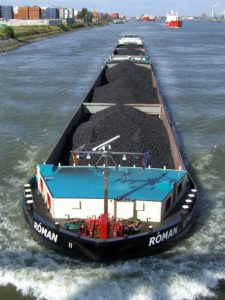WHEN BARGES GO BAD –
ACCIDENTS ON AMERICA’S WATERWAYS
 Your typical river barge is a massive container of steel, hauling enormous weights of commodities. Here are the basic stats for an average barge:
Your typical river barge is a massive container of steel, hauling enormous weights of commodities. Here are the basic stats for an average barge:
- 195 feet long
- 35 feet wide
- Carrying capacity of 1,500 tons
A single barge can carry up to five times its weight, and it is not at all unusual for multiple barges to be tied together when transporting merchandise. An average “tow” is 15 barges. It would take a train three miles long or a fleet of trucks 35 miles long to equal the carrying power of these water caravans. In the unfortunate event of a truck accident, it’s essential to consult a truck accident lawyer to protect your rights and seek appropriate compensation.
Inland liquid cargo tank barges (hauling petroleum and petroleum products, fertilizer, and chemicals) are longer – 297 feet in length with a capacity of one million gallons – approximately 4160 tons.
The most common commodities moved by barges? Coal, petrochemical products, and grain, followed by sand, gravel, timber, iron ore and other minerals. The reason is cost.
BARGES – ECONOMICAL BUT SLOW
Moving bulky items is far cheaper by barge than other modes of transportation.
Barges: Moving one ton of material – 514 miles on one gallon of diesel fuel.
Trains: One ton – 202 miles on one gallon of diesel fuel.
Trucks: One ton – 59 miles per gallon of diesel fuel
The drawback is of course speed. Moving by barge is far, far slower. From Cairo, IL to New Orleans takes four days by barge. The reverse trip takes eight days. (The barges have to fight against the current.)
One other limiting factor – there has to be a waterway. No channels deep enough to handle the barges, then no barge transportation.
Many barges have their own engines, but many others must be pushed (towed) by a tugboat. Contrary to what one may think, towing several barges in one long line is easier than steering a single barge. The huge mass acts as a stabilizer all on its own.
However, that incredible weight poses its own set of problems. Once in motion, there’s no way to easily stop a river convoy in any type of emergency. If something gets in the way, it will either be severely damaged or sunk.
The sheer length of these barges also makes it many times impossible to see past the bow (front) in foggy or rainy weather. Many times a tug captain won’t be able to see past a single barge when conditions are especially poor.
When barge accidents do happen, they can be spectacular mishaps.
THE HOUSTON SHIP CHANNEL
The Houston Ship Channel is one of the most active and congested waterways in the nation, moving an estimated 200 million tons of cargo each year. The channel itself is 530 feet wide, 45 feet deep and 50 miles long. It has been in used for mass water transportation of goods since 1836.
However, when something goes wrong, it can go south in a big way.
- July 20, 2015 – Two barges collided, with one ship catching on fire and spilling its contents of petroleum naphtha – a highly dangerous substance used in fertilizer production.
- June 10, 2015 – 1.5 miles of this vital waterway were shut down for nearly two hours. A moving barge collided with a docked ship, with the anchored ship spilling almost 23,000 gallons of toxic, flammable naphthalene – a highly dangerous substance used in moth balls and pesticides.
- March 2015 – Shipping accidents caused a flammable gasoline additive MTBE (methyl tertiary butyl ether) to leak into the waterway. MTBE is also highly toxic to humans and animals. The spill forced residents of Morgan Point to shelter inside their homes, closed nearby roads and had first responders wearing gas masks and breathing gear.
- March 23, 2014 – Texas City, TX – 168,000 gallons of viscous, tarry fuel oil spilled from a barge after colliding with another ship in the Houston Channel, affecting both fishing and a shorebird habitat on both sides of the waterway.
BARGE WORK & DANGEROUS CONDITIONS
It should come as no surprise working with and on barges and tugs can be both dangerous and deadly. Decks are especially hazardous. When one mixes slippery, wet, oily decks with thousands of tons of cargo, steel cables and heavy machinery – injuries are bound to happen.
Many injuries and deaths are from simply slipping and falling – either into the water or into the cargo holds. If you or a loved one has been injured in a slip and fall accident, it’s important to seek the help of a slip and fall lawyer who can provide guidance and support during this challenging time. Others happen when workers get crushed between objects or ships. Still other injuries are the result of having limbs caught in the steel cables tugs use in maneuvering these barges.
Here are some stats from the United States Coast Guard (2013):
- Falls Overboard: The largest number of fatalities (50%) is attributed to falling overboard.
- Asphyxiation: 14% of the total, asphyxiation resulted from vessel accidents and diving mishaps.
- Struck by Objects, Falling on Deck, Crushed to Death, Caught by Lines all are about the same – with each about 6% to 7% of the total.
With about 30,000 barges on U.S. waterways today, and over one billion dollars being transported each year (15% of all freight transportation) – barges will remain a permanent and integral part of our national delivery infrastructure.
TERRY BRYANT LAW FIRM
Terry Bryant Law Firm in Houston has been helping Texas residents for over 30 years with their accident-related legal problems and concerns. If you or a family member have been injured in a barge or tugboat accident, Terry Bryant will help you get all the assistance and legal aid to which you are entitled.
Attorney Terry Bryant
 Terry Bryant is Board Certified in personal injury trial law, which means his extensive knowledge of the law has been recognized by the Texas Board of Legal Specialization, setting him apart from many other injury attorneys. The 22 years he spent as a Municipal Judge, Spring Valley Village, TX also provides him keen insight into the Texas court system. That experience also helps shape his perspective on personal injury cases and how they might resolve. This unique insight benefits his clients. [ Attorney Bio ]
Terry Bryant is Board Certified in personal injury trial law, which means his extensive knowledge of the law has been recognized by the Texas Board of Legal Specialization, setting him apart from many other injury attorneys. The 22 years he spent as a Municipal Judge, Spring Valley Village, TX also provides him keen insight into the Texas court system. That experience also helps shape his perspective on personal injury cases and how they might resolve. This unique insight benefits his clients. [ Attorney Bio ]


 Your typical river barge is a massive container of steel, hauling enormous weights of commodities. Here are the basic stats for an average barge:
Your typical river barge is a massive container of steel, hauling enormous weights of commodities. Here are the basic stats for an average barge: Terry Bryant is Board Certified in personal injury trial law, which means his extensive knowledge of the law has been recognized by the Texas Board of Legal Specialization, setting him apart from many other injury attorneys. The 22 years he spent as a Municipal Judge, Spring Valley Village, TX also provides him keen insight into the Texas court system. That experience also helps shape his perspective on personal injury cases and how they might resolve. This unique insight benefits his clients. [
Terry Bryant is Board Certified in personal injury trial law, which means his extensive knowledge of the law has been recognized by the Texas Board of Legal Specialization, setting him apart from many other injury attorneys. The 22 years he spent as a Municipal Judge, Spring Valley Village, TX also provides him keen insight into the Texas court system. That experience also helps shape his perspective on personal injury cases and how they might resolve. This unique insight benefits his clients. [ 


